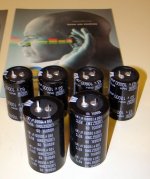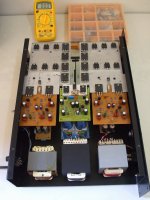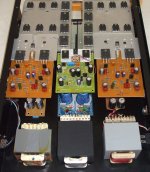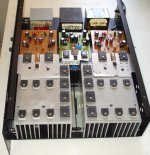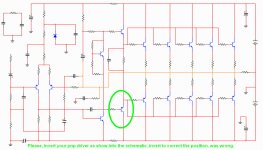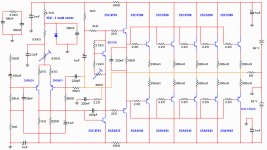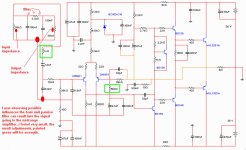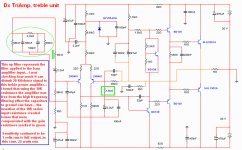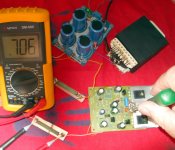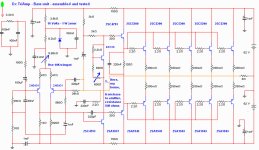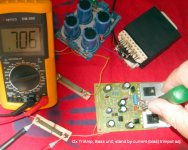So, having 200 wiskies into the bass, i will need 60 to the mids and 20 to the treble.
Those are the average figures, if all speakers have the same sensitivity. They were used in the past to determine the power rating of each speaker. Manufacturers used to combine a 60 W woofer, with a 30 W mid-range and a 10 W tweeter and call it a 100 W three-way speaker.
If you want a flat frequency response, you need the same power for all three ways, adjusted for the different sensitivities. E. g. if the woofer makes 94 dB/W/1 and the tweeter makes 100 dB/W/m you need four times the power for the bass than for the tweeter.
The configuration with 200/60/20 W works, if the bass has 10 dB higher sensitivity than the tweeter and the mid-range has ~5 dB higher sensitivity than the tweeter.
The numbers also shift for different crossover frequencies.
Yeah...and if does not work we gonna fix that and will produce higher power versions
I hope will work.... if not...will be easy to increase power....have just to increase supply voltage and tweak a little the power units.
I have made BiAmp...and really i am using 40 percent to mids and highs...the amplifier has the same power i have into the bass unit, but i am using very low volume to the highs and mids.... the old fashion formula worked to the BiAmp.... i hope will work for TriAmp too.
We are doing dear Pacific...we go testing and doing... and this is positive... try to imagine if Henry Ford have decided heard all criticisms made to him about the assembling line.... people always see problems and logic failures in everything... at least Pacific...me and you...we build things!
People said to Henry Ford that barbecue near an automobile was crazy..because fire and gasoline are not things to be together.
Someone was arrested because told the planet was rounded.
I have no problem to say:
- "Have not worked this way"..... i use to say and i start to do another way.
They go talking and we go building.
regards,
Carlos
I hope will work.... if not...will be easy to increase power....have just to increase supply voltage and tweak a little the power units.
I have made BiAmp...and really i am using 40 percent to mids and highs...the amplifier has the same power i have into the bass unit, but i am using very low volume to the highs and mids.... the old fashion formula worked to the BiAmp.... i hope will work for TriAmp too.
We are doing dear Pacific...we go testing and doing... and this is positive... try to imagine if Henry Ford have decided heard all criticisms made to him about the assembling line.... people always see problems and logic failures in everything... at least Pacific...me and you...we build things!
People said to Henry Ford that barbecue near an automobile was crazy..because fire and gasoline are not things to be together.
Someone was arrested because told the planet was rounded.
I have no problem to say:
- "Have not worked this way"..... i use to say and i start to do another way.
They go talking and we go building.
regards,
Carlos
Last edited:
You're not a caveman.... cavemen wish to be alike you
You are one of the best Acoustic Engineers i have ever met.
Thank you very much...you turn my efforts something positive.
Many pounds?
I see you have surprises to me...as Sakis Petropoulos electrolitic condensers (6) and your gift, the signal generator constitutes and a couple of pounds only.
hehehehe....nice that!..... i will have some surprises.....good!
You know... the key ring, or Key chain...those "chaveiros" from Sakis..with the Eastelectronics brand printed are very needed here..also the generator and the condensers.... i will be waiting alike a children.
Thank you, in advance, by the kindness to transport those things to me.. including your gifts to uncle Charlie.
Carlos
You are one of the best Acoustic Engineers i have ever met.
Thank you very much...you turn my efforts something positive.
Many pounds?
I see you have surprises to me...as Sakis Petropoulos electrolitic condensers (6) and your gift, the signal generator constitutes and a couple of pounds only.
hehehehe....nice that!..... i will have some surprises.....good!
You know... the key ring, or Key chain...those "chaveiros" from Sakis..with the Eastelectronics brand printed are very needed here..also the generator and the condensers.... i will be waiting alike a children.
Thank you, in advance, by the kindness to transport those things to me.. including your gifts to uncle Charlie.
Carlos
Attachments
Last edited:
Hi,
before one can determine the power (signal voltage) to be sent to each driver (speaker) one must know the sensitivity and impedance of each driver.
After this is known or determined then one can calculate or estimate the signal voltage to be supplied to each speaker.
The result of doing this may end up with 90dB/W/m 8ohm bass requiring 100W into 8ohm, 90dB/W/m 6ohm mid requiring 150W into 6ohm and 96dB 8ohm treble requiring 25W into 8ohm.
None of this determination refers in any way to the average power levels in various different parts of the frequency range of any types of music or audio source.
Just as Pacific says
before one can determine the power (signal voltage) to be sent to each driver (speaker) one must know the sensitivity and impedance of each driver.
After this is known or determined then one can calculate or estimate the signal voltage to be supplied to each speaker.
The result of doing this may end up with 90dB/W/m 8ohm bass requiring 100W into 8ohm, 90dB/W/m 6ohm mid requiring 150W into 6ohm and 96dB 8ohm treble requiring 25W into 8ohm.
None of this determination refers in any way to the average power levels in various different parts of the frequency range of any types of music or audio source.
Just as Pacific says
If you want a flat frequency response, you need the same power for all three ways
Dx TriAmp, bass unit, 62V, REVISION III schematic
The PNP driver was fixed...not inverted anymore.
Observe new adjustments to the off set and bias....new values.
Current into each power emitter resistances continue around 1 miliampere
Off set continue to be smaller than 1 milivolt (700uV)
regards,
Carlos
The PNP driver was fixed...not inverted anymore.
Observe new adjustments to the off set and bias....new values.
Current into each power emitter resistances continue around 1 miliampere
Off set continue to be smaller than 1 milivolt (700uV)
regards,
Carlos
Attachments
Here you have more pictures
YouTube - Audio amp, 3 units per channel: bass, mids and highs
regards,
Carlos
YouTube - Audio amp, 3 units per channel: bass, mids and highs
regards,
Carlos
Last edited:
Photo2video and sometimes i am using QR Photo to vídeo converter
The second one has better video effects... when the first one has the same video effects but not so good in timing.
Both are freeware programs, downloaded using google... i have entered into google search: "photo to video"
The Photo2video has a tutorial i have made to my daugther.... but it is in portuguese, i think will not be helpfull to you.
Let me know, forward, your videos produced.. i love that stuff, in special home pictures and electronics.... type "destroyersoueu" into youtube search bar, and you gonna have 150 small videos i have made for fun.
Down the text you have the link to the tutorial in portuguese language, the "how to use"
Needing some help, i can make MP3 audio explaining you some details about these softwares... the second one is limited to 20 pictures... first one has no limits of size.. just write asking and i will return with audio explaining.... people say that can understand my english (englanden) do not forget the ending sufix, that BR, because this is Yahoo Brasil
http://www.youtube.com/watch?v=aNb62FrhIWc
regards to you Barske
Carlos
The second one has better video effects... when the first one has the same video effects but not so good in timing.
Both are freeware programs, downloaded using google... i have entered into google search: "photo to video"
The Photo2video has a tutorial i have made to my daugther.... but it is in portuguese, i think will not be helpfull to you.
Let me know, forward, your videos produced.. i love that stuff, in special home pictures and electronics.... type "destroyersoueu" into youtube search bar, and you gonna have 150 small videos i have made for fun.
Down the text you have the link to the tutorial in portuguese language, the "how to use"
Needing some help, i can make MP3 audio explaining you some details about these softwares... the second one is limited to 20 pictures... first one has no limits of size.. just write asking and i will return with audio explaining.... people say that can understand my english (englanden) do not forget the ending sufix, that BR, because this is Yahoo Brasil
http://www.youtube.com/watch?v=aNb62FrhIWc
regards to you Barske
Carlos
Last edited:
Check up... bass filter possible interference into the midrange amplifier.
Now we have no more worries about.
Real world amplifier is under construction..do not build for a while..maybe some adjustment may be needed... wait.
regards,
Carlos
Now we have no more worries about.
Real world amplifier is under construction..do not build for a while..maybe some adjustment may be needed... wait.
regards,
Carlos
Attachments
Please folks, look forward by the schematic i will publish soon
I have test all amplifiers, and have adjusted each one of them...so...there's the final (real thing) schematic i will post latter..the bass unit, the mid unit and the treble unit...and you will see the final values copied from the amplifiers i have adjusted...they will have the input filter coupled to them into these final schematics.
Also i will post some pictures i have made during the bias adjustment (Rudy asked).
Bias resulted adjusted to 54 miliamperes into the positive rail..off set was adjusted to 1 milivolt... each amplifier, including the input filter that produces insertion losses, will neeed 1 volt RMS of audio in the input to full power... and full power is 25 watts rms (6 ohm) to the tweeter, 65 watts rms (6 ohms) to midrange and 197 watts rms (8 ohms) to the woofer.
Total channel power is 327 watts... to stereo the total power is 650 watts rms.
The image shows the bias adjustment trimpot to the bass amplifier....707 milivolts reading over a 12 ohms resistance resulted in 58 miliamperes
This one uses 4 pairs in the output...the output pair you see is fake..it is there for decoration purposes only...i am using others soldered bellow the board to proceed the adjustment..the bias trimpot adjustment resulted in 840 ohms...and this because each amplifier has different currents for the bootstrapp (VAS too) and different bias settings.... this trimpot, usually floats between 650 ohms and 950 ohms, in most of the sittuations.
regards,
Carlos
I have test all amplifiers, and have adjusted each one of them...so...there's the final (real thing) schematic i will post latter..the bass unit, the mid unit and the treble unit...and you will see the final values copied from the amplifiers i have adjusted...they will have the input filter coupled to them into these final schematics.
Also i will post some pictures i have made during the bias adjustment (Rudy asked).
Bias resulted adjusted to 54 miliamperes into the positive rail..off set was adjusted to 1 milivolt... each amplifier, including the input filter that produces insertion losses, will neeed 1 volt RMS of audio in the input to full power... and full power is 25 watts rms (6 ohm) to the tweeter, 65 watts rms (6 ohms) to midrange and 197 watts rms (8 ohms) to the woofer.
Total channel power is 327 watts... to stereo the total power is 650 watts rms.
The image shows the bias adjustment trimpot to the bass amplifier....707 milivolts reading over a 12 ohms resistance resulted in 58 miliamperes
This one uses 4 pairs in the output...the output pair you see is fake..it is there for decoration purposes only...i am using others soldered bellow the board to proceed the adjustment..the bias trimpot adjustment resulted in 840 ohms...and this because each amplifier has different currents for the bootstrapp (VAS too) and different bias settings.... this trimpot, usually floats between 650 ohms and 950 ohms, in most of the sittuations.
regards,
Carlos
Attachments
Last edited:
The bass unit was built, adjusted and tested.... worked fine!
Here you have schematic and a pictures.
Production started early morning at the Dx Corporation Headquarters.
I have not listened, all three amplifiers playing with their respective drivers...was listened separated, each amplifier and a driver... i felt fine...but, off course, future small modifications into capacitor values (one or two) may be needed to "adapt/match", your amplifier with your speaker.
regards,
Carlos
Here you have schematic and a pictures.
Production started early morning at the Dx Corporation Headquarters.
I have not listened, all three amplifiers playing with their respective drivers...was listened separated, each amplifier and a driver... i felt fine...but, off course, future small modifications into capacitor values (one or two) may be needed to "adapt/match", your amplifier with your speaker.
regards,
Carlos
Attachments
- Status
- This old topic is closed. If you want to reopen this topic, contact a moderator using the "Report Post" button.
- Home
- Amplifiers
- Solid State
- Dx TriAmp bass unit

